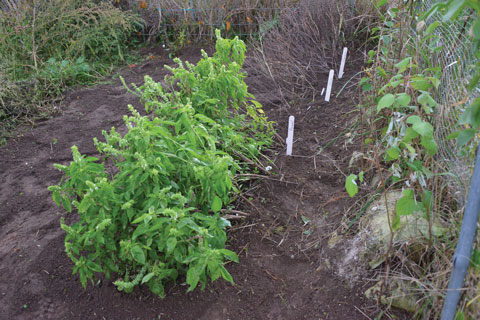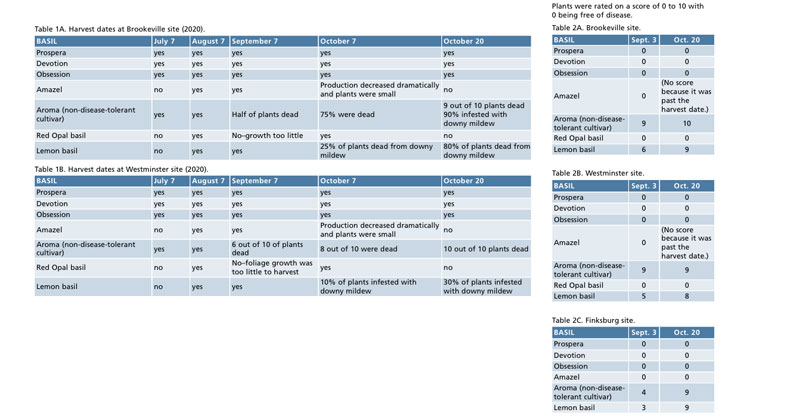2/1/2021
Basil Downy Mildew Field Observations, Part 2
Stanton Gill & David Clement
 Pictured left to right: Basil downy mildew trial on Aroma Basil September 1, 2020.
Pictured left to right: Basil downy mildew trial on Aroma Basil September 1, 2020.
Basil downy mildew symptoms on Aroma on the lower leaf surface September 1, 2020.
Lemon basil showed symptoms on the upper leaf surface September 1, 2020.
Downy mildew continues to be the major disease shortening the life of basil grown outdoors. Rutgers University plant breeders have been working on developing and releasing downy mildew-resistant basil cultivars that came to market in 2019. Plant breeders in Israel have also developed and released cultivars that are reported to be resistant to this disease.
In 2019, we started the first year of a two-year trial to evaluate basil cultivars bred for resistance to downy mildew in outdoor growing conditions. The first year results were published in the April 2020 issue of GrowerTalks.
In 2020, we set up three sites to evaluate downy mildew-resistant basil plants. We planted Amazal, Prospera, Devotion and Obsession as the disease-resistant basils. We planted Aroma and lemon basil at our three sites as downy mildew-prone basils. We also planted the red basil Opal at the Brookeville and Westminster sites since it had shown strong resistance to downy mildew in 2019.
Basil is extensively grown in commercial greenhouses for sale as potted transplants and used in many home landscapes for aesthetic reasons. It’s also used for regular harvesting in summer and fall for home cooking dishes. To say the least, it’s a very popular plant in residential landscapes. In 2020, during the COVID-19 pandemic, many more people were cooking and baking at home. The demand for fresh basil has grown to exceptional levels. Basil looks good as a landscape specimen planting and you can harvest foliage for culinary uses.
Basil is a host for several other diseases, including bacterial leaf spot (Pseudomonas cichorii), gray mold (Botrytis cinerea) and damping off or root rot (Rhizoctonia solani and Pythium spp.). Downy mildew specific to basil is a relatively new problem, first reported in Florida in 2007. Since then, it’s been reported in several eastern seaboard states. In 2008, it was reported in Canadian greenhouses and in greenhouses in South America. The disease is widespread in Europe.
Downy mildews tend to be specific to certain species of plants. Basil has its own downy mildew species called Peronospora belbahrii. Early in the summer season, basil generally isn’t infected, but as the weather becomes warm and humid, the disease shows up, often collapsing whole plants rapidly.
 Pictured: Downy mildew-resistant Amazel (front) and susceptible Genovese Aroma (back).
Pictured: Downy mildew-resistant Amazel (front) and susceptible Genovese Aroma (back).
Basil that’s infected with downy mildew may have a yellowish appearance, similar to a nutritional problem. Yellowing typically first appears in areas along major veins and eventually spreads throughout the leaf. As the disease progresses, the more characteristic symptom of fuzzy grayish-purple sporangia appears on the lower surface of the leaves. When humidity remains high, the chlorotic lesions quickly turn brown.
The disease is most likely introduced and spread through contaminated seeds, infected leaves and wind-dispersed spores. Moderate to warm temperatures and high humidity are favorable conditions for the disease development.
Trials in Maryland
Due to COVID-19 in 2020, we had to move the trial where we held it in 2019 at the Central Maryland Research and Education Center to sites in Brookeville, Westminster and Finksburg. We used Aroma and lemon basil since both, in past years, have had major problems with downy mildew disease.
The Amazel plants were vegetatively rooted; the other basils were started from seeds in a greenhouse. All the plants were established in the growing plots at the three sites in the first week of June 2020. Each plot consisted of 10 plants of each cultivar. We took data on the number of times we could harvest the basil plants in the summer and fall at the Brookeville and Westminster sites. We waited until plants were 20 to 24 in. before each harvest. The foliage was examined and symptoms of downy mildew noted on a 14-day interval.
 Genovese Aroma Basil has strong Fusarium tolerance. Fragrant, smooth 2-in. leaves are tender with the delightful traditional Genovese fragrance. You can make multiple cuts of this productive, slow-bolting variety for many years. Unfortunately, it’s highly susceptible to powdery mildew.
Genovese Aroma Basil has strong Fusarium tolerance. Fragrant, smooth 2-in. leaves are tender with the delightful traditional Genovese fragrance. You can make multiple cuts of this productive, slow-bolting variety for many years. Unfortunately, it’s highly susceptible to powdery mildew.
Amazel Basil from Proven Winners is an Italian sweet basil. It was bred for size, flavor and resistance to downy mildew. Amazel Basil is a sterile, vigorous plant with large foliage, which produces a high yield of usable, aromatic leaves. Amazel had little to no seed set. When it produced a few flowers, we pinched them off and it continued to produce leaves.
Evaluation
In the first year, we evaluated resistance to downy mildew. In 2020 at the Brookeville and Westminster sites, we recorded the number of times the plants reached a 20-in. height and were harvested (Tables 1A and 1B).
On August 30, and September 1, 2020, we found the first indications of downy mildew on the Aroma and lemon basil at the Brookeville site and the Finksburg site, respectively. Downy mildew was found on both lemon and Aroma Basil on September 4 at the Westminster sites. We didn’t see any downy mildew on any of the resistant cultivars at the Brookeville and Westminster sites, and downy mildew wasn’t found on the Opal Red basil plants throughout the trial.
Summary
Amazel, Prospera, Devotion and Obsession as the disease-resistant basils all performed well with good resistance to downy mildew. Amazel did pass its harvest time before Prospera, Devotion and Obsession. The Aroma and lemon basil did well in the early to mid-part of the summer, but succumbed to downy mildew by late summer and continued into the fall with infection and death of plants. The basil Opal wasn’t as productive as the green leaf cultivars, but it also didn’t show any damage from downy mildew.
We’ll continue these trials in 2021 and add any new downy mildew-resistant cultivars that come onto the market. GT
Stanton Gill is Extension Specialist in IPM for Greenhouses and Nursery at the Central Maryland Research and Education Center for the University of Maryland Extension, and Professor at Montgomery College. He can be reached at Sgill@umd.edu or (410) 868-9400; Extension.umd.edu/ipm. David Clement is an Extension Specialist in Plant Pathology for the University of Maryland Extension.